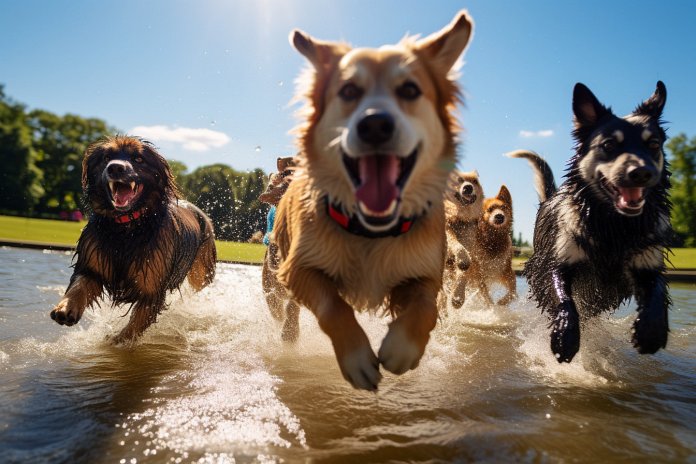
Dogs are amazing animals with incredible talents and intelligence. The diversity of dog breeds allows us to witness a wide range of impressive abilities. Each dog has a unique personality shaped by their history, personality, and environment. They can be trained to perform various tasks, such as providing emotional support, assisting in catching criminals, navigating crowded places, and even predicting seizures. Detection dogs are used in airports and police units to sniff out dangerous items, while tracking and hunting dogs can locate missing people. Some dogs even have acting skills and can play different roles on screen. Dogs also offer therapeutic support for individuals with mental illnesses, providing comfort and calmness. Service dogs assist people with disabilities. All dogs can learn tricks, with positive reinforcement and consistent training.
Signs Your Dog Can Do Things
There are signs that indicate a dog is following a command, such as being alert, attentive, wagging its tail, sniffing, and raising its ears. Other signs include being aware of your voice, maintaining eye contact, responding quickly to commands, and having an upright posture.
History of Dogs Learning to Do Things
The bond between humans and dogs dates back 15,000 years. Dogs evolved from wolves and initially helped humans with hunting and protection. Humans, in turn, provided food and protection for the wolves. Over time, wolves transformed into different breeds of dogs, each with its own set of traits. As humans trained dogs for specific tasks, they also learned additional tricks. With the increasing number of dog breeds, the variety of tricks dogs can perform has grown as well. Dogs today can be trained to do a wide range of tasks, from basic obedience to household chores.
The Science of Dogs Doing Things
Training dogs has numerous benefits. It strengthens the bond between human and dog, reduces anxiety, and improves socialization. Training also helps humans gain a deeper understanding of their dog’s abilities and personality, enhancing communication through vocal and body language cues. The bonding process releases the brain chemical oxytocin in both humans and dogs, promoting feelings of love and peace.
Training Dogs to Do Things
Training dogs can be challenging depending on factors such as their background, age, breed, and personality. Consistency, firmness, and love are essential in the training process. Dogs are more easily trained at a young age, but older dogs can still learn new tricks with regular training. Training not only benefits the dog’s happiness and safety but also increases their intelligence and awareness. Starting with basic commands and gradually progressing to more complex tricks is recommended. Positive reinforcement, such as treats and praise, is effective in motivating dogs to learn and obey commands. Gradually reducing treats and relying more on positive praise ensures that dogs fully grasp and respond to commands.
“Dogs are not just man’s best friend, they are also talented individuals capable of learning and doing amazing things.”

Tips & Things to Know
1️⃣ Dogs have amazing abilities and can be trained to perform a variety of tasks, such as detecting threats, tracking scents, acting, and providing emotional support. Dogs can learn a variety of tricks with positive reinforcement and consistent training.
2️⃣ Understanding a dog’s body language can help you determine if they are following a command. Signs include being alert, listening, wagging their tail, sniffing, and raising their ears. Other signs include being aware of your voice, looking at you without being distracted, responding quickly to commands, and having an upright posture.
3️⃣ Training dogs not only strengthens the bond between humans and dogs but also benefits both parties. Dogs are happier with structure and direction, and training can help with anxiety and socialization. Training also helps humans understand their dog’s abilities and personality, improving communication and the overall relationship. Additionally, training releases oxytocin, a brain chemical associated with love and peace, leading to more positivity in life.
Frequently Asked Questions, Answered ✅
1. What are some tasks that dogs can be trained to do?
– Dogs can be trained to sniff out threatening items like drugs or weapons, track and find missing people, act in movies or TV shows, provide emotional support, and assist people with disabilities.
2. What are some signs that a dog is following a command?
– Signs that a dog is following a command include being alert, listening, wagging its tail, sniffing, and raising its ears.
3. How did the bond between humans and dogs develop?
– The bond between humans and dogs began over 15,000 years ago when wolves helped humans hunt and provided protection. Over time, wolves evolved into various types of dogs with different traits that humans preferred and bred.
4. What are the benefits of training dogs?
– Training dogs strengthens the bond between humans and dogs, helps with anxiety and socialization, improves communication, releases the brain chemical oxytocin which promotes feelings of love and peace, and allows dogs to feel safe and live a happy life.
5. How can you train your dog to do tricks?
– Consistency, firmness, and love are key in training dogs. Starting with the basics and gradually progressing to more complex tricks is recommended. Using treats as rewards initially and then transitioning to more positive praise helps dogs learn and prevents them from relying on treats only when they are hungry.